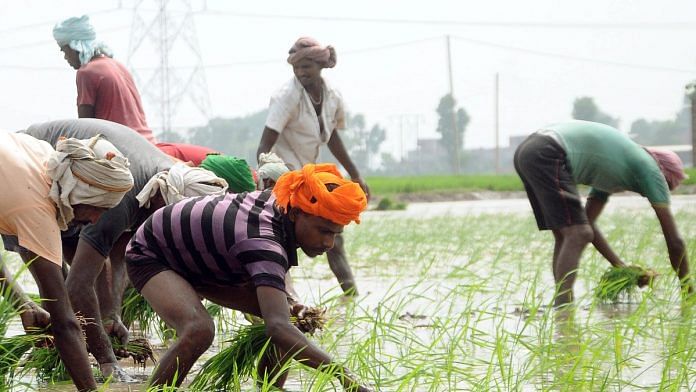New Delhi: An unknown disease has affected rice plants in erstwhile Green Revolution states in northern India, raising fears of its possible impact on overall crop production.
The disease, which leads to severe stunting in paddy, was reported earlier this month by farmers from Punjab, Haryana, western Uttar Pradesh, and Uttarakhand.
Agriculture scientists ThePrint spoke to said the situation is not alarming yet, but needs to be monitored.
A.K. Singh, director of the Indian Agricultural Research Institute (ICAR), Delhi, said that the disease could have either been caused by bacteria (phytoplasma) or a virus (such as tungro and grassy stunt virus, both of which affect standing rice crops).
“We have to rule them out one by one following DNA and RNA sequencing tests,” he told ThePrint. “But farmers will have to be vigilant. Sucking pests like planthoppers could be a vector and spread the disease to healthy plants. So, these pests will have to be controlled by chemical applications.”
Ajmer Singh Dhatt, director of research at Punjab Agricultural University, Ludhiana, said that the incidence is low so far, but the disease has been reported in multiple states.
“Our assessment is that the damage will be marginal and we have been trying to find out the exact cause for the past two weeks or so,” Dhatt added.
The mystery disease is a cause for concern since the affected fields are in high rice-yielding states. Rice yield in Punjab is over 4.5 tons per hectare compared to 2.5 tons per hectare for the entire country.
Also Read: Good news from the farm as India’s FY22 foodgrain production estimated at record 316 mn tonnes
Why the worry
According to ICAR director A.K. Singh, the damage done by the disease ranges from 5-6 per cent to upto 20 per cent of the crop area in some regions.
The diseased plants have poorly developed root systems, which affect nutrient delivery from soils. The stunting is severe, the affected plants are up to one-fourth the height of a normal plant.
“At most, yield losses are likely to be limited to 1-2 per cent due to the ability of healthy rice plants to have more grain-bearing bunches, also known as tillering,” Singh said. When a rice plant gets more space to grow, he explained, it develops more grain-bearing branches, which in turn means higher yield, and this could help compensate for the loss.
In the ongoing Kharif season, a drought in parts of Uttar Pradesh, West Bengal, Bihar, and Jharkhand has stoked fears of lower crop production and export curbs.
The likely loss to rice production follows a reduced wheat crop due to a heat wave ahead of harvest in March and April.
(Edited by Uttara Ramaswamy)
Also Read: Lower kharif plantings due to uneven rains a growing concern, says report



